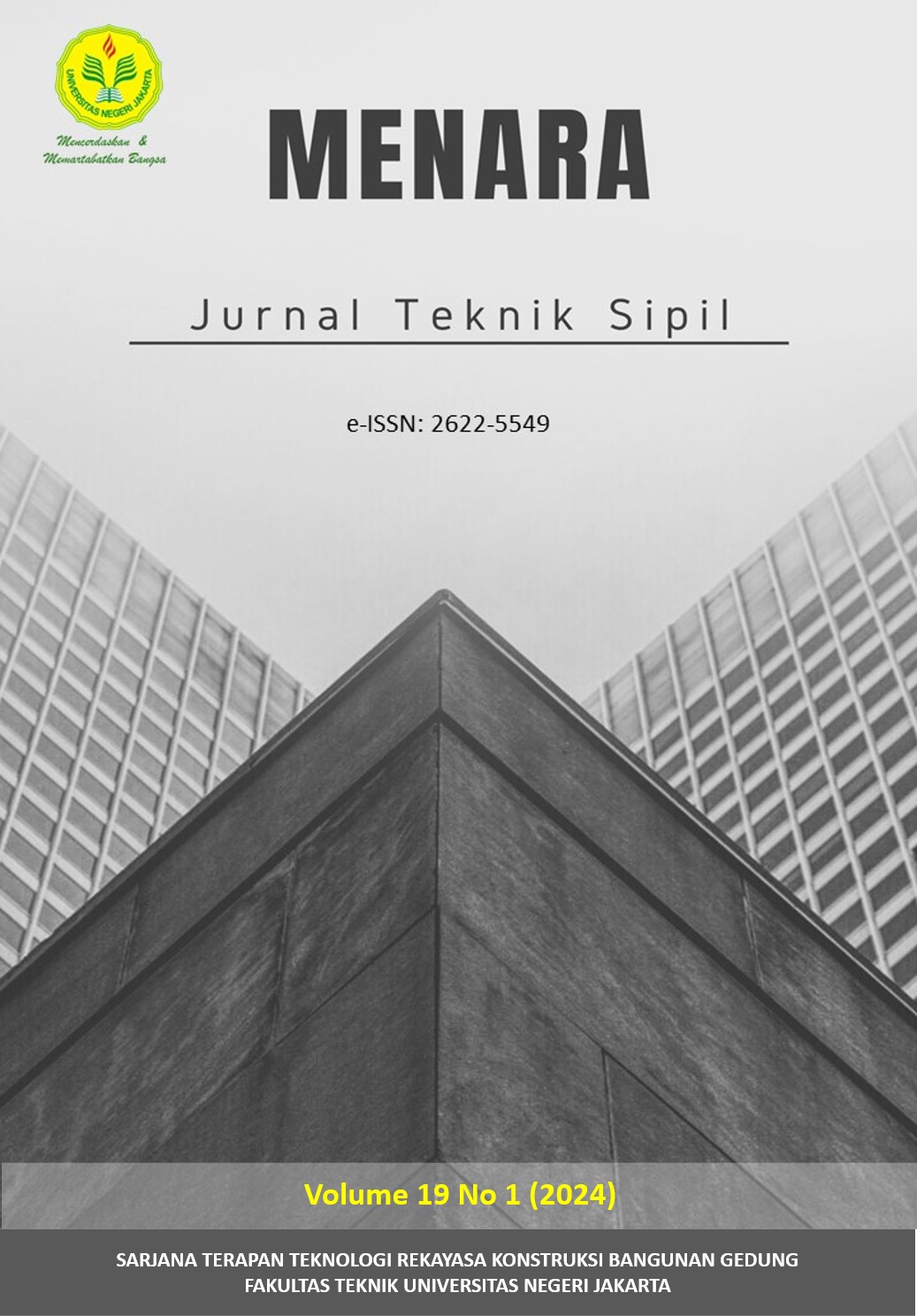IDENTIFIKASI KERUSAKAN JALAN METODE PCI STUDI KASUS DI RUAS JALAN KABUPATEN GRESIK
DOI:
https://doi.org/10.21009/jmenara.v19i1.37398Keywords:
Kerusakan jalan, Pavement Condition Index, Penanganan.Abstract
Research on level and types of road damage in Golokan – Ujung Pangkah Street, Gresik Regency using PCI (Pavement Condition Index) method aimed to determine the dominant degree and level of road damage as well as the sequence road priority which must be immediately taken the handling based on the results of road damage condition score of the roads. The PCI score is calculated by substracting the value of 100 with maximum CDV (Corrected Deduct Value), PCI = 100 – CDV = 100 – 22=78. Based on the results, it can be concluded that types of damages on Golokan – Ujung Pangkah Street, Gresik Regency is based on the ASTM D6433-11 and Guidance of Highways, the highest PCI score was 90 ( Excellent ) and the lowest one was 58 ( Good), and it is recommended for the damage handling to conduct routine maintenance in the form of 4 Cm and 7 Cm overlay works.
References
Al-Neami, M. A., Al-Rubaee, R. H., & Kareem, Z. J. (2017). Evaluation of Pavement Condition Index for Roads of Al-Kut City. Article in International Journal of Current Engineering and Technology, 7(4), 15. http://inpressco.com/category/ijcet
Gemo, A. S. (2020). Evaluasi Kerusakan Jalan Dengan Metode Pavement Condition Index (Pci) Pada Ruas Jalan Ki Hajar Dewantara Kota Borong. Evaluasi Kerusakan Jalan Dengan Metode Pavement Condition Index (Pci) Pada Ruas Jalan Ki Hajar Dewantara Kota Borong, 2, 1–8. https://ejournal.itn.ac.id/index.php/sondir/article/view/2598
Girsang, L. E. P. (2018). KAJIAN KRITERIA PENENTUAN SKALA PRIORITAS PADA PROYEK PENANGANAN JALAN NASIONAL (Studi Kasus Satuan Kerja Pelaksanaan Jalan Nasional Wilayah II Provinsi Sumatera Utara). Jurnal Poli-Teknologi, 17(1). https://doi.org/10.32722/pt.v17i1.1100
Kristiana, R., Sunandar, A., & Sediyanto. 2022. “Analisis Pengaruh Peran Stakeholders Pada Proyek Kawasan Hunian Berbasis Pendekatan Risiko”. Jurnal Ilmu Teknik dan Komputer, Vol. 6 No. 1. https://publikasi.mercubuana.ac.id/index.php/jitkom/issue/view/696
Lang, J. 2014. “Pavement Management Systems, Road Construction and Maintenance Spring”.
Munandar, A. Widodo, S. & Sulandari, E. (2017). Analisa Kondisi Kerusakan Jalan Raya pada Lapisan Permukaan. Jurnal Mahasiswa Teknik Sipil Universitas Tanjungpura, 4(4), 207522.
Pradnyadari, N. L. M. A. M., Yansen, I. W., & Wiranata, A. A. (2016). Estimasi Biaya Konstruksi Gedung Berdasarkan Indeks Harga Bahan dan Upah Tenaga Kerja (Kabupaten Badung dan Kabupaten Tabanan). A Scientific Journal of Civil Engineering, 20/2(Juli 2016), 142–147.
Pramono, T. W., Rahmawati, A., & Adly, E. (2016). Analisis kondisi kerusakan jalan pada lapis permukaan mengunakan metode Pavement Condition Index (studi kasus Jalan Imogiri Timur, Bantul, Yogyakarta). 1–10.
Darius, R. T. Y., Mulyono, T., Hadi, W. 2020. “Optimalisasi Kapasitas dan Tingkat Pelayanan di Koridor Jalan Raya Bogor Segmen Pasar Cisalak”. Menara: Jurnal Teknik Sipil Volume 15, No. 1, 2020. https://journal.unj.ac.id/unj/index.php/menara/article/view/18035.
Taufikkurrahman, T. (2020). Evaluasi Tingkat Kerusakan Jalan Berdasarkan Metode Pci (Pavement Condition Index). SISTEM Jurnal Ilmu Ilmu Teknik, 16(3), 28–38. https://doi.org/10.37303/sistem.v16i3.190
Trisnawati, Luh Dewi. 2015. “Analisis Kinerja Proyek Terhadap Kepuasan Stakeholders”. Program Pascasarjana Universitas Udayana, Denpasar. https://jurnal.umj.ac.id/index.php/konstruksia/article/view/6964/0.
Vaitkus, A., Kleizienė, R., & Karbočius, M. (2021). Viastructura – A New Way Of Pavement Structure Design. IOP Conference Series: Materials Science and Engineering, 1202(1), 012018. https://doi.org/10.1088/1757-899x/1202/1/012018
Wirnanda, I., Anggraini, R., & Isya, M. (2018). Analisis Tingkat Kerusakan Jalan Dan Pengarunya Terhadap Kecepatan Kendaraan (Studi Kasus: Jalan Blang Bintang Lama Dan Jalan Teungku Hasan Dibakoi). Jurnal Teknik Sipil, 1(3), 617–626. https://doi.org/10.24815/jts.v1i3.10000
Downloads
Published
Issue
Section
License
Copyright (c) 2024 siswoyo, Akhmad Maliki, Soepriyono Soepriyono

This work is licensed under a Creative Commons Attribution-ShareAlike 4.0 International License.
Authors who publish with this Journal agree to the following terms:
- Author retain copyright and grant the journal right of first publication with the work simultaneously licensed under a creative commons attribution licensethat allow others to share the work within an acknowledgement of the work’s authorship and initial publication of this journal.
- Authors are able to enter into separate, additional contractual arrangementfor the non-exclusive distribution of the journal’s published version of the work (e.g. acknowledgement of its initial publication in this journal).
- Authors are permitted and encouraged to post their work online(e.g. in institutional repositories or on their websites) prior to and during the submission process, as it can lead to productive exchanges, as well as earlier and greater citation of published works.











